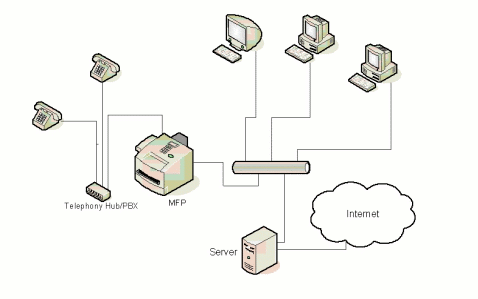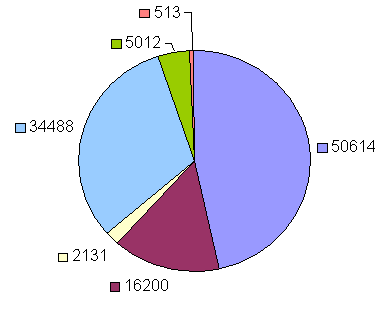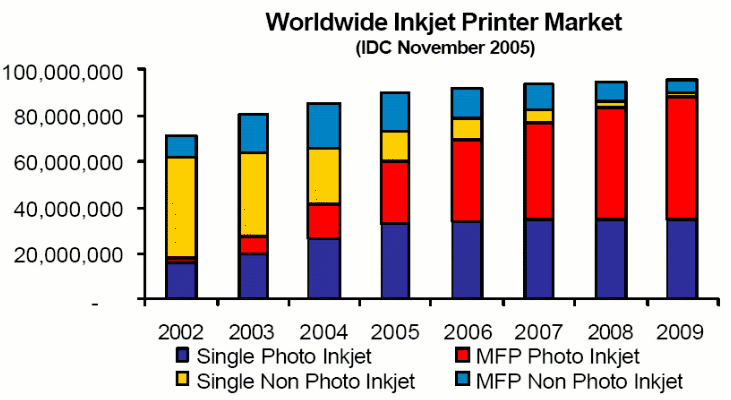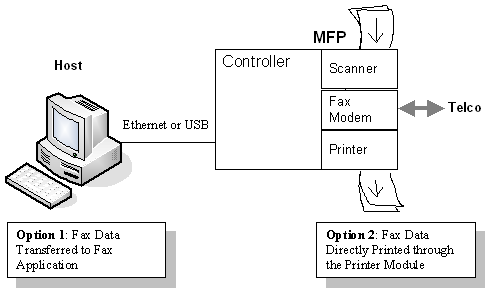MFP – Multi Function Peripherals/Printers
MFP Defined
Multi-Function Peripherals or Printers (MFPs), are quickly commandeering territory in today’s home and business offices due to their quality, versatility, reliability, ease of use, small size, and the improvements they bring to productivity. As the name implies, these all-in-one, stand-alone units are capable of performing multiple functions including advanced printing, faxing, scanning and photocopying.
General Features of MFPs
- Class 1 and Class 2 fax functionality compliant with ITU-T V.34, V.17, V.29, V.27ter facsimile standards
- Printing and scanning of common raster image data format
- Multi-tasking capability and network friendly
- Scalable architecture with optional full-featured command sets allowing mid to high-end solutions
- Provides structure for proprietary language transport, rendering, and remote printing
In Figure 1, we see a typical setup of a small IT infrastructure. The MFP, a single unit occupying only the space of a large laser printer, takes the place of a printer, scanner, photocopier, and fax machine. The result – maximum workflow efficiency and cost savings to a business.

The MFP Market
Owing to the performance and advantages of MFPs, their appeal to small and large businesses has grown tremendously in recent years. The foremost reason why more businesses are choosing MFPs is to save office real estate and capital costs while providing employees access to as many peripherals as possible to maximize their productivity. From the vendor’s point-of-view, the MFP market is reaching full-throttle. In fact, recently and for the first time, market share of stand-alone units has seen a decline mainly due to the rapid growth in the MFP market as manufacturers look to roll-out product with increased functionality at more affordable prices. To achieve the later, MFP manufacturers continually look for ways to save on production costs. One of the most significant cost-savings is realized by implementing a software-based fax solution.
Market Statistics
The US MFP market experienced double-digit growth over the last several years. In 2005, the unit shipments [totalled] 17.1 million units valued at $11.1 billion. IDC studies indicate that the MFP market will continue to grow well into 2010.
Sahaja Sarathy, research analyst, U.S. Hardcopy Peripherals Trackers says, “The overall MFP market showed positive growth rates across all technologies in 2005. Inkjet MFP growth helped strengthen its presence over its single-function counterparts with a majority share during 2005. Monochrome laser MFPs matched the growth of laser printers, while the highest excitement was perhaps seen in the color laser MFP segment, as the less than one-thousand dollars products brought about a disruption of sorts in the color devices landscape.” 2004 was the first year in which shipments of MFP units rose in comparison to single-function printers, scanners, or fax machines.
Worldwide trends matched that of the United States. The Gartner Group study on the EMEA (European, Middle East, African) market indicates, “Colour page copier and inkjet MFP sales fuelled the market in the first half of the year [2006], increasing by 98 percent and 24 percent respectively compared to the same period last year.” In Canada alone, sales of MFPs enjoyed a staggering 49.4% rise in the second half of the year, according to George Bulat, IDC Canada’s director of Data-Driven Products Inc. mMore than 400,000 MFPs were shipped across the country in the fourth quarter of 2004.” according to George Bulat, IDC Canada’s director of Data-Driven Products Inc. Mr. Bulat states, “Double-digit increases in two consecutive quarters is certainly an indication of a growing market.” Evans Research Corporation analyst Bill Fournier corroborates that 2004 was the first year in which shipments of MFP units rose in comparison to single-function printers, scanners, or fax machines.
On the global frontWith respect to color laser printers and MFP with color laser printing function, “IDC forecasts that worldwide shipments of color laser printers and MFPs will grow from 3.9 million units in 2005 to over 7 million units by 2009,” says Keith Kmetz, program director of Hardcopy Peripherals Solutions and Services at IDC.
Figure 2 shows the global market distribution amongst single and multi-functional devices in 2004.

As Figure 2 depicts, sales of single-function machines were around 63% while those of MFPs were 37%; however MFP sales grew significantly. For example, there was a 29% increase in sales for inkjet-based MFPs.
Growth Trends and Projections
Weakening sales for single-function printers are attributed to the growing popularity of MFPs. The use of MFPs has spread faster in small and medium enterprises (SMEs) compared to larger corporations, according to Mason Olds, vice-president of Canon Canada’s Imaging Systems Group. The reason is that MFPs enable smaller business owners to save about 10 percent off the cost of four separate devices. They also use up less space in small offices. According to figures from Evans Research Corp, MFP sales made up about 18% of the printer market in 2002 which grew to 37% by 2004.Figure 3show the IDC’s projections for the inkjet MFP market.

MFP Functional Architecture
The various functions of MFPs can be summarized in terms of data transmission within its functional architecture: host/PC, fax modem, scanner, printer, and internal memory, illustrated as follows:
| Source | Destination | |||
| Host/PC | Fax Modem | Printer | MFP Memory | |
| Host/PC | Rendering/ Conversion | Computer Fax Send | Store Data | |
| Fax Modem | Computer Fax Receive | - | Fax-Print | Store Fax to Memory |
| Scanner | Scan to Host | Scan Fax Transmit | Photocopy | Store Scanned Page to Memory |
| MFP Memory | Retrieve Data | Memory Content Transfer | Hardcopy Memory Dump | Data Conversion |
The host/PC is an interface between the user and the MFP. The host can send and receive data to and from the MFP, using it very much like a traditional computer peripheral providing conventional printing and scanning functions. The host can also send data to the MFP to have it transmitted as a fax, or receive a fax call from the MFP and save the incoming fax data as a file on the computer. When or if the host is offline, the MFP can store received faxes in its internal memory where the host can retrieve them at a later time.
Fax Functions
An MFP device may support many different facsimile capabilities. Some of the standard fax capabilities include:
- Host controlled fax transmission and reception
- Stand-alone fax transmission, reception, copy, and data storage
- Binary File Transfer (BFT) to remote host

Figure 5 represents a typical scenario where an MFP is being used for fax reception/transmission. The embedded fax modem connects to the phone line and is controlled by the internal MFP controller. Depending on the desired level of integration, the fax module can be either class 1, completely controlled by the MFP controller, or class 2 and only activated by the MFP controller such that a host PC can control the fax process through an AT command interface. Input data for fax transmission can come from the host PC, the scanner, or the MFP’s internal memory. Output from a fax reception can be sent to and displayed on the host PC, saved to the MFP’s internal memory, and/or directly printed.
The GAO Advantage
GAO Research is a major supplier of embedded fax, modem and telephony software and has achieved great success in enabling its customers in their deployment of state-of-the-art multi-function peripherals. Because of sizeable cost savings over chipsets, flexibility and customization that software offers, superior specifications seen in the end product, and the ability to perform future upgrades through firmware rather than a change of hardware, GAO’s MFP manufacturing customers lead the industry in both innovation and design. Because of its field-proven software fax technology and industry reputation, GAO Research will continue to lead the market in embedded software fax technology for the multi-function peripherals as the demand for MFP solutions continues to rise.
Software Solution: A More Economical and Flexible Option
GAO software-based fax protocol and modem solution for MFPs is a low cost, flexible and reliable when compared to conventional hardware-based fax modem chipsets. Both software and hardware solutions are designed to be compliant to specific ITU-T standards. GAO software is optimized to run on existing DSPs or microprocessors embedded as part of the MFP hardware along with other control and user application software. Aside from that, GAO’s fax solution requires only a hardware analog front-end (AFE). In contrast, a hardware fax modem chipset also requires an AFE and may also require a host processor, which itself may require a separate crystal as its clock, additional external memory, and other discrete electronic components. Additional circuitry will be required between these additional components. A hardware interface will also need to be designed to interface the chipset with the host processor. All of this translates to increased per-unit cost. Conversely, the GAO software fax solution results in a product with a lower component count, a smaller PCB footprint, a smaller BOM, a smaller size, lower weight and lower power consumption.
GAO software fax solution provides flexibility in accommodating the ever-evolving communications standards, changing command interfaces, the need for improved support and services, and the integration of data, fax, and voice related applications integral to MFPs. It also provides the opportunity to add customized features since GAO’s solution is based on software algorithms, thus customized changes in its design may only require changes to the source code. It is impractical to achieve the same level of customization with hardware-based chipsets without a complete hardware re-design, which means a tremendous cost factor.
Modular and Optimized For Embedded Applications
GAO’s embedded software fax solutions are optimized for all common embedded hardware platforms. Through optimization, processing and memory requirements of the software fax modem is reduced, allowing more features to be implemented by the MFP because of the freed resources or allowing the use of lower cost DSP or microprocessors. For example, features such as additional modulation capabilities or telephony features can be added to higher-end systems, whereas a reduced modem command set can be implemented with a smaller memory footprint on reduced systems.
Versatility in Fax Modulations
Today’s MFPs are using a software-based fax modem such as GAO Research’s embedded fax modem technology. The software suite generally consists of the fax data pumps ITU compliant V.34, V.17, V.29, V.27ter, and V.21 channel 2, as well as the T.30 fax control protocol, all implemented as embedded software. GAO’s software fax modem technology provides for both low and high-speed color or monotone fax, and is suitable for deployment in any full-line of stand-alone fax machines or MFP.
Functionality Enhancements with Advanced Telephony Features
GAO’s software fax solutions for MFPs include supporting telephony features such as Dual-Tone Multi-Frequency (DTMF) generation and detection, and Call Progress. Other optional telephony software such as Caller-ID (CID) can provide further functionality for feature-rich MFPs.
Functionality Enhancement with GAO T.38/Relay/FoIP Modules
GAO embedded fax software also includes Fax Relay and T.38 modules that can enable an MFP device with appropriate network peripherals to function as a T.38 fax gateway, hence enabling FoIP connections over TCP/IP and UDP networks. GAO embedded fax software can be used to communicate with gateways using the standard T.38 protocol.
